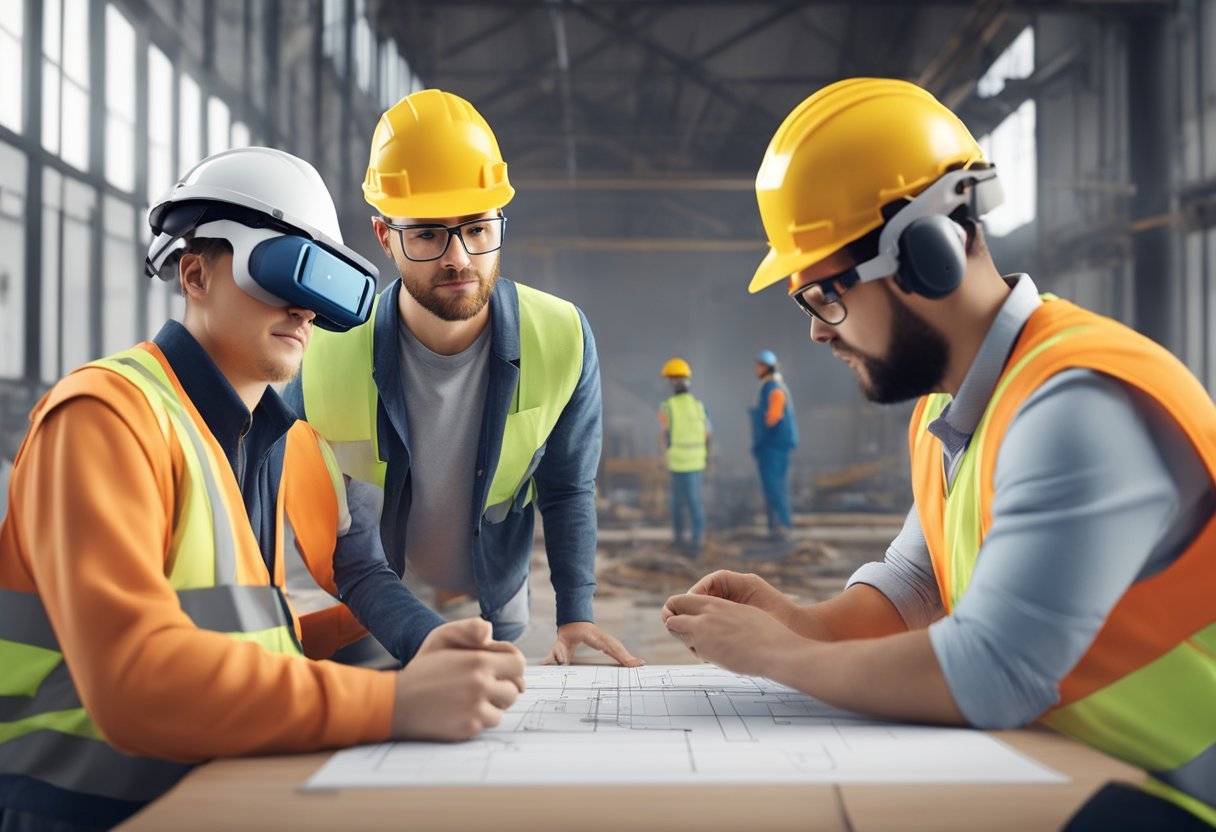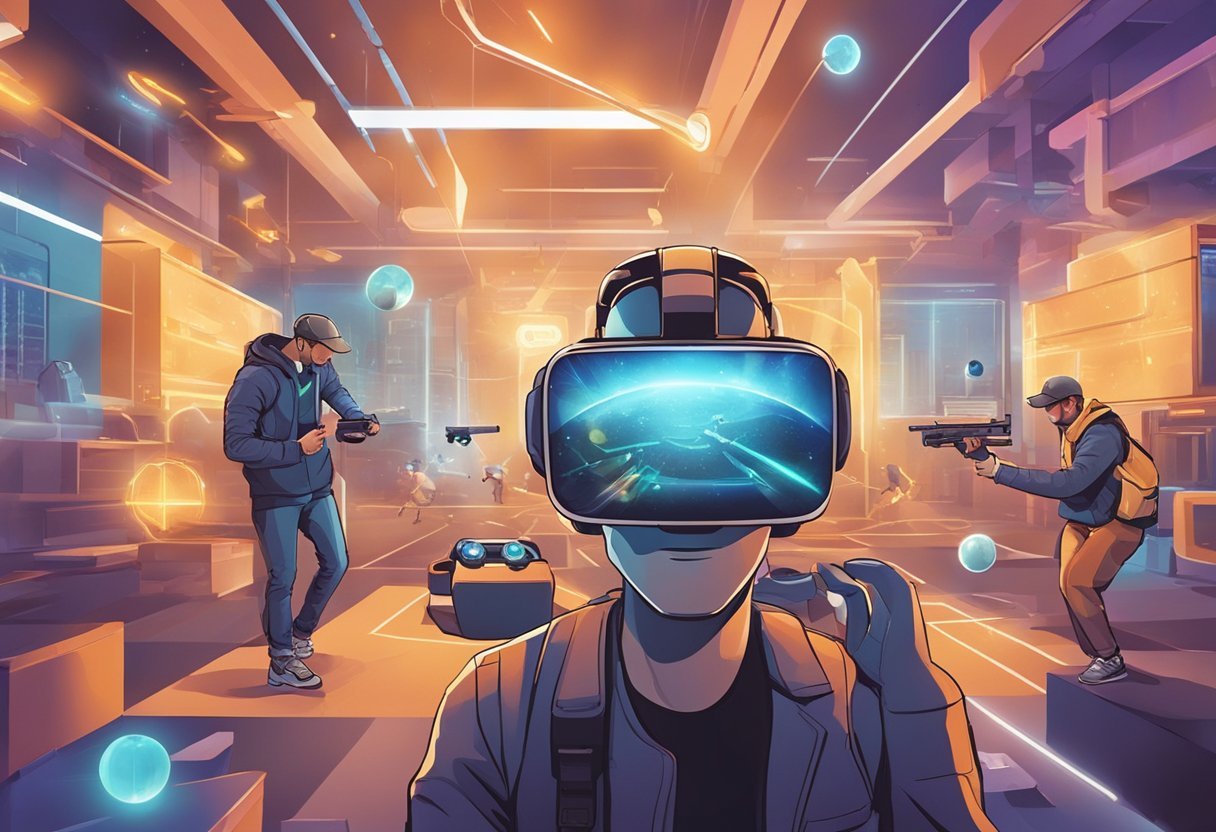Augmented reality (AR) is a technology that has been gaining traction in the construction industry. AR is a computer-generated image that is superimposed onto the real world, creating an interactive experience that can be used to enhance construction projects. With the help of AR, construction companies can visualize their projects in a more realistic and efficient way, which can ultimately save time and money. In this blog post, I will discuss Augmented reality in construction companies and share with you 9 companies using AR in construction.
AR has many applications and benefits in the construction industry. For example, AR can be used to visualize building designs and layouts, which can help construction workers understand the project better. AR can be used to provide real-time information to construction workers, such as safety warnings and equipment instructions. By using AR, construction companies can improve their workflow and increase efficiency on the job site.
Integrating AR with construction technologies can be challenging, and there are many considerations and obstacles to overcome. However, as the technology continues to evolve, we can expect to see more advancements in AR for construction.
Augmented Reality in Construction
Augmented reality (AR) is a technology that has the potential to revolutionize the construction industry. AR refers to the ability to overlay digital information onto the real world, allowing users to interact with virtual objects in real-time. In the construction industry, AR can be used to improve safety, reduce errors, and increase efficiency.
The Role of Augmented Reality in Construction
AR has the potential to play a significant role in the construction industry. By overlaying digital information onto the real world, AR can help workers visualize construction plans and identify potential issues before they arise. AR can also be used to provide workers with real-time information about safety hazards and construction progress, reducing the risk of accidents and delays.
The Evolution of AR in the Construction Industry
AR is a relatively new technology in the construction industry, but it has already shown great promise. As the technology continues to evolve, we can expect to see even more innovative uses for AR in the construction industry. For example, AR could be used to create virtual walkthroughs of construction sites, allowing workers to visualize the finished project before construction even begins.
AR Use Cases in the Construction Industry
There are many potential use cases for AR in the construction industry. For example, AR could be used to overlay digital information onto construction plans, allowing workers to visualize the finished project in real-time. AR could also be used to provide workers with real-time information about safety hazards and construction progress, reducing the risk of accidents and delays.
In addition, AR could be used to create virtual walkthroughs of construction sites, allowing workers to visualize the finished project before construction even begins. This could help to identify potential issues before they arise, reducing the risk of costly delays and errors.
AR is a technology that has the potential to revolutionize the construction industry. By overlaying digital information onto the real world, AR can help workers visualize construction plans, identify potential issues, and improve safety. As the technology continues to evolve, we can expect to see even more innovative uses for AR in the construction industry.
9 Companies using Augmented Reality in Construction
- Trimble
- BIM 360 (Autodesk)
- Procore
- Matterport
- Fieldbit
- Scope AR
- Plangrid (Autodesk)
- ViewAR
Trimble
Trimble is a company that uses AR in construction through its suite of solutions designed to improve productivity and efficiency. Trimble’s AR technology integrates with tools like SketchUp and Trimble Connect, allowing users to visualize 3D models in a real-world context through mobile devices or AR glasses. This helps in understanding complex structures, verifying designs against actual conditions, and identifying potential issues before they arise. Trimble’s AR solutions also aid in precise on-site assembly and in navigating users to specific locations for tasks, improving accuracy and reducing the likelihood of errors during construction.
BIM 360 (Autodesk)
BIM 360 by Autodesk is a cloud-based construction management platform that incorporates AR for enhanced project visualization and collaboration. It allows users to access 3D models and project data on-site, facilitating real-time decision-making. AR features in BIM 360 enable teams to overlay digital blueprints onto the physical environment, streamlining inspections and quality assurance. The platform also supports collaboration across project teams, helping to keep everyone aligned on project objectives and progress.
Procore
Procore’s construction management software leverages AR to provide users with a comprehensive view of their projects. With AR capabilities, Procore helps teams visualize complex workflows and understand the spatial relationships of different project components. This visualization can be particularly useful for project planning, design validation, and identifying potential clashes before they become costly issues. Procore’s AR features aim to enhance collaboration, allowing stakeholders to interact with project models in an intuitive and immersive way.
Matterport
Matterport specializes in creating digital twins of physical spaces, which can be particularly useful in construction for documentation, inspection, and project management. Their AR technology enables users to capture 2D and 3D data of a site and create detailed walkthroughs that can be accessed remotely. This allows construction professionals to assess and share the condition of a project at any stage, facilitating better communication and decision-making without the need for physical presence on-site.
Fieldbit
Fieldbit provides an AR platform primarily for field service and maintenance, which can be applied in the construction industry for on-site support and training. Their AR solution allows experienced technicians to remotely guide on-site personnel through complex installations or repairs using real-time annotations and visual instructions. This hands-on guidance aims to minimize downtime and improve first-time fix rates, which is crucial for maintaining project timelines and budgets in construction.
Scope AR
Scope AR offers AR tools that support worker training and guidance in construction. Their WorkLink platform allows companies to create interactive AR content for training purposes, enabling workers to learn in an immersive environment. Remote AR is Scope AR’s live support solution that lets experts remotely assist on-site personnel through AR-enabled devices, providing real-time visuals and instructions. This can significantly improve the efficiency and quality of construction processes by reducing errors and enhancing skill development.
Plangrid (Autodesk)
Plangrid, another Autodesk product, is a construction productivity software that incorporates AR to facilitate project planning and coordination. It allows users to overlay project plans onto the physical construction site, providing a clear guide for work to be done. Plangrid’s AR features also enable field workers to access drawings and documentation hands-free, increasing efficiency and reducing the risk of errors. The platform streamlines communication by allowing team members to annotate and share updates in real-time, directly on the project plans.
ViewAR
ViewAR is a company that offers an AR system for creating and visualizing 3D models in real-time. In construction, ViewAR’s technology can be used for interior planning, design visualization, and space management. Their system allows users to place virtual objects within a physical space, assisting in layout decisions and design approvals. ViewAR’s solutions aim to simplify the design process and enhance the client experience by providing a realistic representation of the final project before construction begins.
Applications and Benefits of AR
Augmented reality (AR) is a rapidly growing technology that is finding its way into many industries, including construction. AR technology allows construction companies to visualize 3D models and building information modeling (BIM) in a real-world setting, making it easier to plan, design, and construct buildings. In this section, we will explore the various applications and benefits of AR in construction.
Enhancing Design and Visualization
AR technology allows you to visualize your designs in a real-world setting, which can help you identify any design flaws or issues before construction begins. By using AR, you can create a 3D model of a building and overlay it onto the construction site. This can help you visualize the finished product and make any necessary adjustments to the design.
Improving Accuracy and Efficiency
AR can also improve the accuracy and efficiency of construction projects. By using AR technology, you can create a digital representation of the construction site, which can help you identify any potential issues before construction begins. This can help you avoid costly mistakes and delays during the construction process.
Safety and Training Applications
AR technology can also be used for safety and training applications. By using AR, you can create a virtual training environment that simulates real-world scenarios. This can help workers learn the necessary safety procedures and protocols before they are put in a real-world situation. AR can be used to identify potential safety hazards on the construction site, which can help prevent accidents and injuries.
AR technology is a valuable tool for construction companies. It can enhance design and visualization, improve accuracy and efficiency, and be used for safety and training applications. By incorporating AR into construction projects, companies can save time and money while improving the overall quality of their work.
Integrating AR with Construction Technologies
Augmented Reality (AR) is a powerful tool that can be integrated with other construction technologies to enhance project planning, modeling, and real-time data. By integrating AR with Building Information Modeling (BIM), collaboration tools, and mobile applications, construction companies can streamline their processes and reduce errors.
Building Information Modeling (BIM) Integration
BIM models are 3D digital representations of a building that include detailed information about its physical and functional characteristics. By integrating AR with BIM, construction companies can create a more immersive experience for their clients by allowing them to visualize the building before it is built. AR can also be used to overlay BIM models onto the physical site, allowing workers to see the design in real-time and make adjustments as needed.
Microsoft HoloLens and Autodesk Revit are two examples of tools that can be used to integrate AR with BIM. Microsoft HoloLens is a wearable device that allows users to overlay digital information onto the physical world. Autodesk Revit is a BIM software that allows users to create detailed 3D models of buildings.
Collaboration Tools and Mobile Applications
Collaboration tools and mobile applications can also be integrated with AR to enhance communication and collaboration between team members. AR can be used to overlay digital information onto the physical world, allowing workers to see real-time data and make informed decisions.
Arki and Gamma AR are two examples of mobile applications that can be used to integrate AR with collaboration tools. Arki is a mobile application that allows users to create and share 3D models of buildings. Gamma AR is a mobile application that allows users to overlay BIM models onto the physical site.
Integrating AR with other construction technologies can enhance project planning, modeling, and real-time data. By using tools such as BIM integration and collaboration tools, construction companies can streamline their processes and reduce errors.
Challenges and Considerations
When implementing augmented reality (AR) in construction companies, technical limitations and costs are among the primary challenges to consider. AR requires advanced hardware and software, which can be costly to acquire and maintain. The technology may not be compatible with existing systems and workflows, requiring significant investments in infrastructure and training.
To mitigate these challenges, it is important to conduct a thorough cost-benefit analysis before investing in AR technology. This analysis should consider the potential benefits of AR, such as reduced errors, improved efficiency, and increased safety, against the costs of implementation, including hardware, software, and training.
User Adoption and Training
Another challenge to consider when implementing AR in construction companies is user adoption and training. AR technology is relatively new, and many workers may be unfamiliar with its use. This can lead to resistance to adoption and a steep learning curve for those who do adopt it.
To address this challenge, it is important to provide comprehensive training to workers on the use of AR technology. This training should cover both the technical aspects of the technology and its applications in the construction industry. It is important to involve workers in the implementation process to ensure their buy-in and to identify potential areas for improvement.
While there are challenges to implementing AR in construction companies, the potential benefits of the technology make it a worthwhile investment. By considering technical limitations and costs and addressing user adoption and training, construction companies can successfully integrate AR into their workflows and improve their efficiency and safety.
Future Trends and Innovations
As the construction industry continues to mature, innovation and technology are playing an increasingly important role in shaping its future. Augmented Reality (AR) is one such technology that is rapidly gaining traction in the construction industry. It is being used to improve project management, marketing, and sales, among other things.
Advancements in AR Hardware
AR hardware is evolving rapidly, with companies like ARVizio and VisualLive leading the way. These companies are developing AR headsets that are specifically designed for use in the construction industry. These headsets are lightweight, durable, and have a long battery life. They are also equipped with advanced sensors and cameras that allow workers to overlay digital information onto the real world.
AR in Project Management and Marketing
AR is also being used to improve project management and marketing in the construction industry. Project managers can use AR to visualize 3D models of construction projects in real-time. This allows them to identify potential issues and make changes before construction begins. AR is also being used to create immersive marketing experiences for potential buyers. This allows them to view virtual models of buildings and see how they will look once they are completed.
AR is set to play a significant role in the future of the construction industry. Advancements in AR hardware are making it easier for workers to overlay digital information onto the real world. AR is also being used to improve project management and marketing in the construction industry. As the technology continues to evolve, we can expect to see even more innovative uses of AR in the construction industry.
Case Studies and Real-World Examples
Success Stories in Construction
Augmented Reality (AR) has been an invaluable tool for construction companies in recent years. It has helped project managers, engineers, architects, and workers to communicate more effectively and with greater confidence. AR has been used successfully in various construction projects, and the following case studies demonstrate its effectiveness.
One example is the use of AR by the construction company Mortenson. They used AR to help visualize their construction projects and communicate more effectively with their clients. AR allowed their clients to see the construction process in real-time, which helped to build trust and confidence.
Another example is the use of AR by the construction company Skanska. They used AR to help with quality control on their construction sites. AR allowed them to visualize the construction process and identify potential issues before they became problems.
Comparative Analysis of AR Implementation
AR has become an increasingly popular tool in the construction industry, and many companies are now using it to improve their construction processes. However, there are still some challenges that need to be addressed to ensure its successful implementation.
A comparative analysis of AR implementation in the construction industry shows that the most successful companies are those that have a clear understanding of how AR can be used to improve their processes. They have invested in the necessary hardware and software and have trained their employees on how to use it effectively.
Furthermore, successful companies have also identified the specific areas where AR can be most effective, such as project management, quality control, and client engagement. They have also developed clear communication channels to ensure that everyone involved in the construction process is aware of the benefits of using AR.
AR has proven to be an invaluable tool in the construction industry. Its success lies in its ability to improve communication, increase confidence, and provide real-time visualization of construction processes. By investing in the necessary hardware and software and training employees on how to use it effectively, construction companies can reap the benefits of AR and improve their construction processes.
Frequently Asked Questions
What is the difference between AR and VR in construction?
AR and VR are both digital technologies that can be used in the construction industry. Augmented reality (AR) is a technology that overlays digital information onto the real world, while virtual reality (VR) creates a completely immersive digital environment. AR is more commonly used in construction because it allows workers to see and understand critical details of a building or jobsite in context.
What company uses augmented reality?
Several companies in the construction industry are currently using augmented reality technology. Some of the leading companies include Trimble, Autodesk, and DAQRI.
Who is the market leader in augmented reality?
The market leader in augmented reality varies depending on the industry. In the construction industry, Trimble is considered one of the market leaders in augmented reality technology.
What industries benefit from augmented reality?
Augmented reality technology can benefit several industries, including construction, healthcare, education, and retail. In construction, AR can help with project planning, design, and communication among workers.
What are the benefits of augmented reality in construction?
Augmented reality technology can provide several benefits to the construction industry. AR can help workers visualize designs and plans in real-world environments, which can help with project planning and communication. AR can also help with safety by providing workers with real-time information about hazards and other potential risks.
Which industry does augmented reality contribute the most?
The construction industry is one of the industries that can benefit the most from augmented reality technology. AR can help with project planning, design, and communication among workers. It can also improve safety by providing workers with real-time information about hazards and other potential risks.
Which industry is investing most in augmented reality technologies?
Several industries are currently investing in augmented reality technologies, including healthcare, education, and retail. However, the construction industry is also investing heavily in AR technology to improve project planning, design, and communication among workers.




